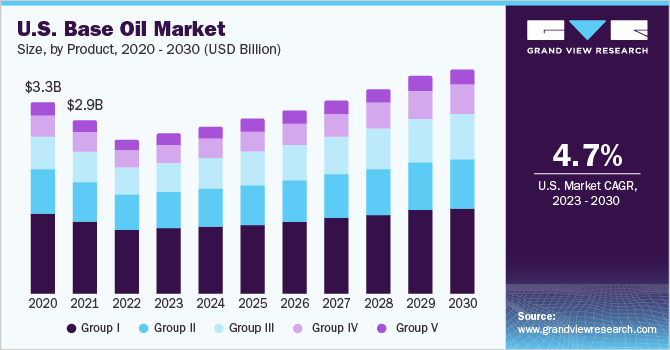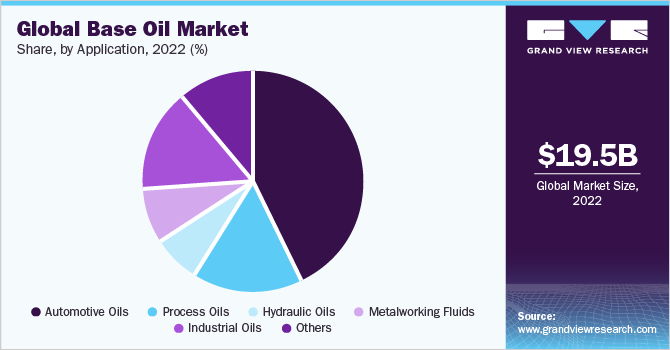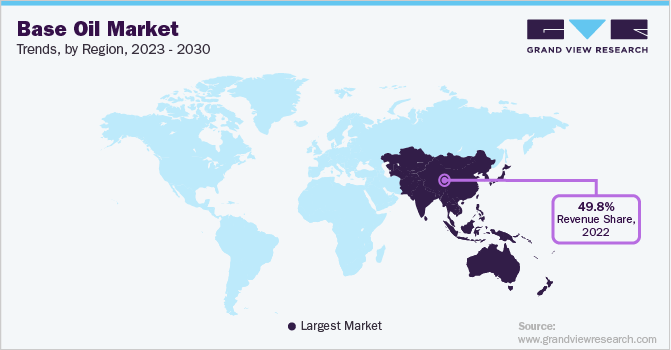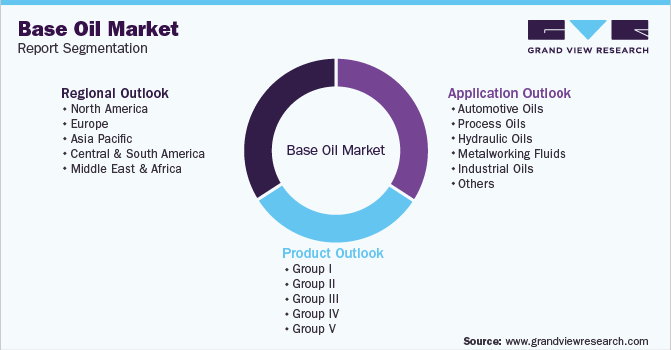- Home
- »
- Petrochemicals
- »
-
Base Oil Market Size, Share & Trends Analysis Report, 2030GVR Report cover
![Base Oil Market Size, Share & Trends Report]()
Base Oil Market (2023 - 2030) Size, Share & Trends Analysis Report By Product (Group I, Group II, Group III), By Application (Automotive Oils, Process Oils, Industrial Oils), By Region, And Segment Forecasts
- Report ID: GVR-1-68038-097-2
- Number of Report Pages: 130
- Format: PDF
- Historical Range: 2018 - 2021
- Forecast Period: 2023 - 2030
- Industry: Bulk Chemicals
- Report Summary
- Table of Contents
- Segmentation
- Methodology
- Download FREE Sample
-
Download Sample Report
Base Oil Market Summary
The global base oil market size was estimated at USD 19.46 billion in 2022 and is projected to reach USD 29.89 billion by 2030, growing at a CAGR of 5.5% from 2023 to 2030. The growth is attributed to increasing utilization of engine oils from industries such as metallurgy, automotive, chemicals, heavy equipment, and power generation.
Key Market Trends & Insights
- By region, Asia Pacific held the largest market share of 49.8% in 2022.
- China is projected to lead the Asia Pacific base oil market over the forecast period.
- By product, Group I base oils dominated the market with a revenue share of 42.5% in 2022.
- By application, automotive oil dominated the market with a revenue share of 42.% in 2022.
Market Size & Forecast
- 2022 Market Size: USD 19.46 Billion
- 2030 Projected Market Size: USD 29.89 Billion
- CAGR (2023–2030): 5.5%
- Asia Pacific: Largest regional market in 2022
The market is highly fragmented with presence of a large number of highly innovative players. The competition is intense as the participants engage in maintaining their customers to have a competitive edge over each other. Companies are adopting collaborative business strategy to increase their productivity, provide highly regarded products to consumers, and expand their regional presence.

Base Oil is critically utilized in the lubricant oil formulation globally with widespread application across a multitude of industries. Group I base oils are majorly utilized in marine lubricants which are widely utilized in the shipping industry to protect and enhance the efficiency of engines and equipment. These are high-performance marine lubricants that require high viscosity base oils, specially designed to enable optimal performance in operations.
Currently, the automotive sector is one of the major contributors to base oils globally. The demand for lubricants in manufacturing vehicles is expected to show continuity in its growth, however, the trend of electric vehicles has reduced the after sales growth for certain lubricants. Consumers are looking for standard and specialized products to satisfy specific requirements and thus lubricant manufacturers are investing in new product developments especially for the automotive industry. The growing consumption of lubricant manufacturers is anticipated to propel the demand for base oils over the forecast period.
Developing economies such as China, India, and Indonesia etc. are driving the manufacturing sector across the globe. According to World Bank, the value added of the manufacturing sector towards GDP was around 14% in 2021, an increased from the previous year. The growth is supported by the availability of raw material, reduced infrastructure cost, and labor cost. Owing to these factors base oil manufacturers are also shifting and expanding their production units in developing nations.
Product Insights
Group I product dominated the market with a revenue share of 42.5% in 2022. This is attributed to increase in usage in automotive, marine, and rail lubricants due to their affordability, simple processing, low volatility, high viscosity index, and lubrication properties. Group I product are classified as greater than 0.03% sulfur, less than 90% saturates, and viscosity range from 80 to 120. This group is characterized by its low aromatic compound content and paraffinic nature. The temperature range is from 32˚F to 150˚F. Compared to all other groups, group I are less refined and are a mixture of different hydrocarbon chains with little uniformity.
Group II product accounted for the second largest revenue share in the year 2021. This is because of its easy availability and new capacity additions near the countries in Asia Pacific and Middle East region coupled with competitive prices. Globally, over 90% volume of lubricants can be formulated from group II type. The prices of Group II type are close to that of group I, therefore, they have become common in the market.
Application Insights
The automotive oils application dominated the market with a revenue share of 42.8% in 2022. Its high share is attributable to increasing demand for greases, gear oil, engine oil, and others for lubricating the automobile components. Globally, truck engines and automobiles are the major consumers, consuming over 20 million tons of lubricants per year, accounting for about half of the total lubricant use. With vehicle manufacturers pushing toward meeting pollution standards, the automobile market is anticipated to prompt oil companies to produce base oils.

The demand for automobile oils is anticipated to witness noteworthy growth due to rising popularity of fragrance products for homes in developed economies such as Germany, the U.K., the U.S., and Canada. Blended, paraffin, beesbase, palm, and soy base oils are the most commonly purchased automobile oils in the market.
Process oil accounted for the second largest revenue share globally because of its application in a wide variety of technical and chemical industries either as an aid to processing or as a raw material. They play a vital role in several applications such as polymer industry, foam control, agriculture, sealants, leather goods manufacture, textile production, civil explosive production, and others.
Regional Insights
Asia Pacific region dominated the market with a revenue share of 49.8% in 2022. This is attributed to the presence of emerging economies and increasing disposable income of people in the region making it an attractive market for lubricant manufacturers. Asia Pacific is one of the largest product market globally, with China being the dominant country in the region.

China is projected to lead the Asia Pacific base oil market over the forecast period. The dominance is attributed to the increased use of automobiles and the rapid growth of manufacturing industry in the country. The market in China is also supported by the accessibility of raw materials, increased foreign investments, rapid industrialization, and a growing population. Similarly, the market in India is expected to witness a high growth rate owing to the strong presence of several base oil producers, and rapid infrastructure development undertaken by the government of India.
Europe attributed for the second largest revenue share globally for the year 2021. High consumption of lubricants is considered a key driver for the growth of the market in Europe, as lubricants are mainly composed of base oil. The high consumption of base oil is closely associated with the growth of the transportation and industrial sectors. In addition, the total number of passenger vehicles in use grew by 3.8%, and that of commercial vehicles grew by 3.7% from 2005 to 2015.
Key Companies & Market Share Insights
The global base oil market is fragmented in nature. The key industry participants have recognized the future growth prospects of base oil market across the world and as such, are constantly acquiring small- or medium-sized firms. They are merging with other companies for producing base oils in large volumes. These leading players are also introducing innovative products in the market. Such initiatives undertaken by the companies operating in the global base oil market are ensuring their stronghold in the market.
Several regional companies are enhancing their production capacity and entering into joint ventures with other companies to increase their global presence. Companies such as Exxon Mobil Corporation and ADNOC focus on expanding their production capacity and enhancing their market share through acquisitions and mergers. For instance, Exxon Mobil Corporation completed its expansion project of the Singapore refinery in August 2019. Some of the prominent players in the base oil market include:
-
CNOOC Limited
-
PetroCanada Lubricants Inc.
-
Pertoleum & Chemical Corp. (SINOPEC)
-
PETRONAS Lubricants International
-
PT Pertamina (Persero)
-
PetroChina Co., Ltd
-
Exxon Mobil Corporation
-
Abu Dhabi National Oil Company
-
Chevron Corporation
-
Shell plc
-
Indian Oil Corporation Ltd
-
BP p.l.c
-
Saudi Arabian Oil Co.
-
Sepahan Oil
-
Bahrain Lube Base Oil Company
-
LUKOIL
-
SK Lubricants Co., Ltd.
-
H&R OWS Chemie GmbH & Co. KG
-
Bharat Petroleum Corporation Limited
-
GS Caltex Corporation
-
Neste
-
Repsol
Base Oil Market Report Scope
Report Attribute
Details
Market size value in 2023
USD 20.17 billion
Revenue forecast in 2030
USD 29.89 billion
Growth rate
CAGR of 5.5% from 2023 to 2030
Base year for estimation
2022
Historical data
2018 - 2021
Forecast period
2023 - 2030
Quantitative units
Revenue in USD Million, Volume in Kilotons and CAGR from 2023 to 2030
Report coverage
Revenue forecast & volume forecast, company ranking, competitive landscape, growth factors, and trends
Segments covered
Product, application, region
Regional scope
North America; Europe; Asia Pacific; Central & South America; Middle East & Africa
Country scope
U.S.; Canada; Mexico; Germany; U.K.; Italy; France; Spain; China; India; Japan; Thailand; Malaysia; Brazil; Argentina; Saudi Arabia; South Africa
Key companies Listed
CNOOC Limited; PetroCanada Lubricants Inc.; Pertoleum & Chemical Corp. (SINOPEC), PETRONAS Lubricants International; PT Pertamina (Persero); PetroChina Co., Ltd; Exxon Mobil Corporation; Abu Dhabi National Oil Company; Chevron Corporation, Shell plc; Indian Oil Corporation Ltd; BP p.l.c; Saudi Arabian Oil Co.; Sepahan Oil; Bahrain Lube Base Oil Company; LUKOIL; SK Lubricants Co., Ltd.; H&R OWS Chemie GmbH & Co. KG; Bharat Petroleum Corporation Limited; GS Caltex Corporation; Neste; Repsol
Customization scope
Free report customization (equivalent up to 8 analysts working days) with purchase. Addition or alteration to country, regional & segment scope. Pricing and purchase options
Avail customized purchase options to meet your exact research needs. Explore purchase options Global Base Oil Market Report Segmentation
This report forecasts revenue growth at global, regional, and country levels and provides an analysis on the latest industry trends in each of the sub-segments from 2018 to 2030. For the purpose of this study, Grand View Research has segmented the global base oil market report on the basis of product, application, and region:

-
Product Outlook (Volume, Kilotons; Revenue, USD Million, 2018 - 2030)
-
Group I
-
Group II
-
Group III
-
Group IV
-
Group V
-
-
Application Outlook (Volume, Kilotons; Revenue, USD Million, 2018 - 2030)
-
Automotive Oils
-
Process Oils
-
Hydraulic Oils
-
Metalworking Fluids
-
Industrial Oils
-
Others
-
-
Regional Outlook (Volume, Kilotons; Revenue, USD Million, 2018 - 2030)
-
North America
-
U.S.
-
Canada
-
Mexico
-
-
Europe
-
Germany
-
U.K.
-
France
-
Italy
-
Spain
-
-
Asia Pacific
-
China
-
India
-
Japan
-
Thailand
-
Malaysia
-
-
Central & South America
-
Brazil
-
Argentina
-
-
Middle East & Africa
-
Saudi Arabia
-
South Africa
-
-
Frequently Asked Questions About This Report
b. Key factors that are driving the market growth include increasing utilization of lubricants in end-use industries such as industrial & automotive and growing adoption of group II & III base oils.
b. The global base oil market size was valued at USD 19.46 billion in 2022 and is expected to reach USD 20.17 billion in 2023.
b. The global base oil market is expected to grow at a compound annual growth rate of 5.5% from 2023 to 2030 to reach USD 29.89 billion by 2030.
b. The Asia Pacific dominated the base oil market with a share of 49.8% in 2022. This is attributable to the development of the automotive industry along with the resultant demand for finished lubricants to improve the operational efficiency of the vehicle imparting longer life.
b. Some key players operating in the base oil market include ExxonMobil, Chevron Corp., British Petroleum PLC, Royal Dutch Shell, Sepahan Oil Company, LukOil, Saudi Aramco, S-Oil Corp., Indian Oil Corp. Ltd., Total, Motul, Repsol, Gulf Oil UAE, Petrobras, and Tupras.
Share this report with your colleague or friend.
Need a Tailored Report?
Customize this report to your needs — add regions, segments, or data points, with 20% free customization.

ISO 9001:2015 & 27001:2022 Certified
We are GDPR and CCPA compliant! Your transaction & personal information is safe and secure. For more details, please read our privacy policy.
Trusted market insights - try a free sample
See how our reports are structured and why industry leaders rely on Grand View Research. Get a free sample or ask us to tailor this report to your needs.










